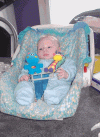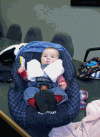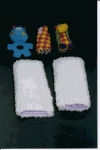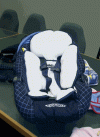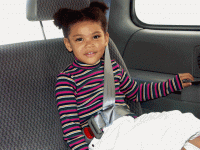TP 2436
Road Safety Leaflet # D-2004-01 (E)
Problem:
During the past few years, third-party aftermarket products for car seats have become very popular to the consumer. Transport Canada has identified that many of these products could be considered a safety risk when added to an infant seat, a child seat or a booster cushion. A third-party aftermarket product is one that is designed to be used with the car seat but was not supplied with the car seat or by the manufacturer of the car seat.
Background:
Transport Canada investigated two separate collisions in which two different aftermarket products were used in conjunction with an infant seat and may have contributed to the serious injury and/or death of the infants.
Health Canada has contacted Transport Canada to explore the safety of several aftermarket products.
Transport Canada has discussed this matter with the major manufacturers of children's restraint systems to identify their concerns. The manufacturers have also raised concerns about how these third-party aftermarket products may interfere with the safety features of their car seats.
A decision has been made to publish this Consumer Notice to inform the public of the potential risks these products may pose. Transport Canada regulates the actual restraint systems, but there are no regulations or standards that regulate the third-party aftermarket products. Car seat manufacturers generally state in their instructions that no third-party aftermarket products should be used with their restraint systems.
Safety Risk:
Some aftermarket products can cause safety issues ranging from inducing slack in the shoulder harness system to adding compressible material behind the child, which during a crash will allow for slackness in the harness system. The resulting slack in the harness may cause the child to be either partially or fully ejected from the restraint system, in the event of a crash or sudden stop. In other instances, the third-party aftermarket product may position a hard surface in front of a child that could pose an injury to the child should the child make contact with it in the event of a crash. When choosing one of these products it is always advisable to first check with the car seat manufacturer concerning safety issues that may be posed with the use of the product.
The following is a summary of some of the more common products:
Harness Strap Covers: These covers wrap around the shoulder harness system of the restraint. These products can prevent the chest clip from being positioned at the armpit level of the child. The chest clip is required at this position to ensure that the harness straps stay in place holding the child in the restraint in the event of a crash or sudden stop. Without the chest clip located at the proper place on the child's body, there is an increased risk of the child being ejected.
In addition, some of the harness covers available have hard teething products velcroed onto them. The addition of hard objects is not recommended as they can injure the child in the event of a crash or sudden stop.
Add-on Trays: These products that add-on to forward-facing restraints and booster cushions may incorporate a footrest and a hard plastic tray. The unit is attached to the restraint system by the weight of the restraint and the occupant resting on the device. Any hard object placed in front of a child may result in a head injury should a crash or sudden stop occur.
Head Support Cushions: If the manufacturer incorporates a head support cushion with the restraint system, then the manufacturer has tested it for that model and make of restraint. Should a head support cushion that is purchased separately be used, then it is possible that the slots in the head support cushion may not line up with the slots in the restraint for the harness system. By re-routing the harness system to accommodate the aftermarket head support cushion, slack may be induced into the harness system, which may increase the likelihood of ejection from the car seat in the event of a crash.
Additional Padding Behind the Child: Any additional padding behind the child can induce both slack in the harness and additional compressibility. The Standard, which regulates children's restraint systems, only allows for a certain amount of compressibility in the foam and material used. By increasing this amount, during a collision the additional foam/material can compress to the point that the harness system becomes very loose and therefore no longer is capable of restraining the child.
Padded Car Seat Bags: Child seat manufacturers state in their instructions not to use bulky clothing and never add anything between the shell of the restraint and the child. The padded car seat bag can re-route the harness system and add slack and increase compressibility. Check with the car seat manufacturer before using and ensure that the product does not compromise the harness routing path.
Mobiles: Mobiles are becoming common as they keep the child occupied during road trips. These products normally hang from the handle of a rear-facing infant restraint. If these mobiles are constructed of a hard plastic, during a collision they could injure the child. Normally the car seat manufacturer recommends that the handle of the restraint be in the down position while traveling in a vehicle. Check your car seat instructions before using.
Other Issues Associated with Children Traveling in a Vehicle:
Winter Clothing: Bulky snowsuits can affect the harness with respect to additional compressibility. In addition, many snowsuits are made of very slippery material. This can affect the harness system should the chest clip of the restraint not be used properly. When using bulky winter clothing ensure that the harness system is tight, compressing the material to ensure a snug fit. Check with the car seat manufacturer for alternative methods of clothing during the winter.
Seat Belt Adjusters: Third-party aftermarket seat belt adjusters have become very common. Many of these products pull the shoulder portion and the lap portion of the seat belt together. This tends to pull the shoulder portion of the seat belt off the face of the child but normally pulls the lap portion of the seat belt up onto the soft abdominal area. In the event of collision, the location of the lap belt can cause serious injury or death to the occupant. There are other types of adjusters available, all of which are designed to pull the shoulder belt away from the face of a child and all of which change the configuration of the lap belt. If an aftermarket product is required to re-configure the seat belt assembly to sit over the shoulder and low on the hips, then the child should probably be in a booster cushion.
Recommended Action:
Although the products summarized above are not reflective of all third-party aftermarket products available, these appear to be the most common. Modification of any kind by the addition of third-party aftermarket products could reduce the effectiveness of the child restraint system and therefore prevent the restraint from performing as designed resulting in an injury to your child.
Please be advised, that any aftermarket product produced by the restraint manufacturer for use with their products have been tested with their products and are acceptable for use with their products.
It is the recommendation of Transport Canada and the manufacturers of children’s restraint systems, that caution be used by parents if selecting aftermarket products. Understanding the potential hazards is important when selecting and using third-party aftermarket products. In no case should any product be used that interferes with the proper positioning and adjustment of the child restraint harness or other safety features of the car seat. To be sure it is best to consult with the manufacturer of the car seat before using any aftermarket product.
Transport Canada: 1-800-333-0371
Release Date: April 7, 2004
